In advance of BioBeat19: Accelerating Cell and Gene Therapy, hosted by GSK and Stevenage Bioscience Catalyst, we are exploring how to protect your intellectual property in this field. The summit will be held on 19 November 2019 at the GlaxoSmithKline Research & Development Stevenage Campus. This half day event is for scientists, investors and entrepreneurs. Leading women will discuss opportunities and catalyse ideas with the audience. Register here: https://www.biobeat19.org/
Research into cell and gene therapies has boomed in recent years. These methods have been hailed as disruptive innovations, due to their ability to cure rather than merely treat diseases. The therapies work in complementary and sometimes overlapping manner. Cell therapy works by altering a set of cells ex vivo before introducing them into the subject to effect the therapy. Gene therapy works by introducing, replacing or deleting specific genes within a cell either in vivo or ex vivo.
A recent report published by the Alliance for Regenerative Medicine and the BioIndustry Association highlights that the UK is a thriving ecosystem for transformative therapies such as cell and gene therapy. For example, there are over 70 companies developing Advanced Therapy Medicinal Products (ATMPs) in the UK, and the UK industry is predicted to be worth £10 billion by 2035. Cell and gene therapy open up the possibility of developing curative medicaments, suitable for a wide variety of diseases from cancer to infectious diseases. The field is rapidly developing in terms of research and the regulatory provisions required to get these treatments to market. However, due to high cost and the length of time to take these therapies to approval means that it is essential to have an effective IP strategy in place to maintain your market position.
These therapies are completely different from a standard small molecule drug, and as such require a more unique patenting strategy. Further, in the field of biological therapies there are a number of potential issues that can arise. Both the European and the US patent systems include a number of exceptions to patentability which are relevant to biological material and natural products. For example, in Europe inventions related to stem cells derived from the destruction of human embryos are unpatentable along with methods of treatment by therapy or surgery of the human body. In the US, the patent eligibility landscape has changed in recent years in view of a number of Supreme Court decisions and has become more restrictive. Now, the USPTO guidance states that for natural phenomena and natural products to be patentable they must demonstrate characteristics which are “markedly different” from their natural counterpart.
However, despite the exceptions to patentability, there are multiple aspects of cell and gene therapies which are eligible for patent protection. The development and production of a cell therapy involves many stages including removing cells from a patient, performing the required modification procedure before reintroducing them to effect their modified purpose within the subject. Therefore, each of these stages may yield innovations suitable for patent protection. In general, the product that is administered may be a modified population of cells, since this population is unique in each case it can be difficult to define in order to obtain a product claim. However, for therapies such as CAR-T, claims to a modified population of cells expressing the specific receptor may be suitable along with claims to the component parts used to modify the cells or genes such as vectors and nucleases. Process claims can also be very useful in this field, these may be directed to the methods used to culture, manipulate or modify the cells for use as therapies.
To obtain effective IP protection any IP strategy in this area needs to take into account the differences in European and US patent practice. Also, due consideration must be given to third party IP in this increasingly crowded field to avoid infringement of third party right.








